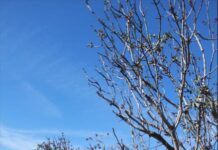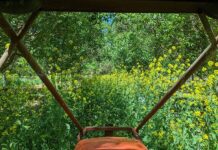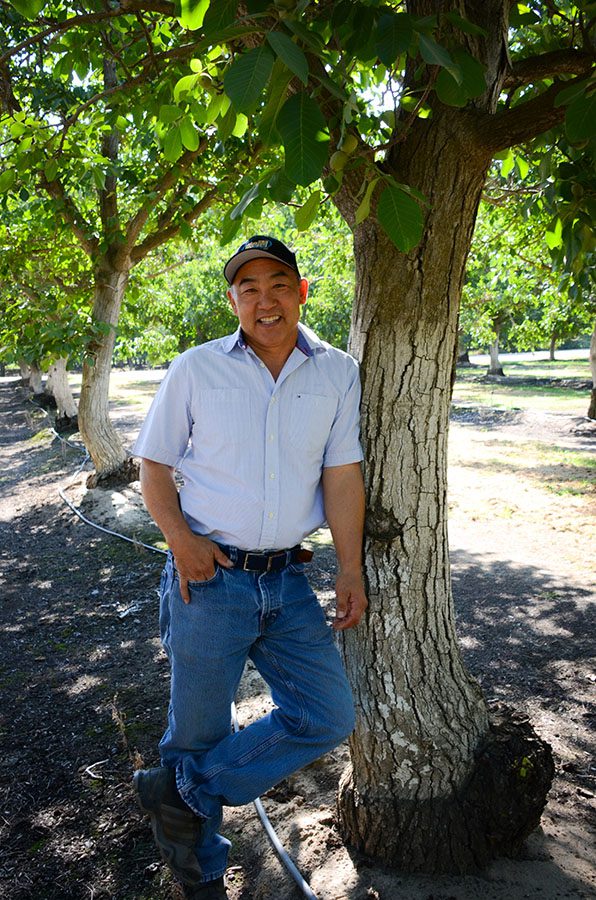
Mike Miya of Miya Farms in Hanford, Calif. farms the same land his grandparents worked in the 1920s. He and his brother, Mark, and sister, Melynda, farm nearly 500 acres of almond, pistachio and walnut. But they don’t expect the next generation to follow in their footsteps.
“We will hopefully keep farming for a number of years, but we don’t have the fourth generation,” he says. “It doesn’t look like they want to come into farming. I think in farming these days, you have to be pretty educated. Sometimes that education is not always going to lead you to agriculture. My son is an aerospace engineer, and my daughter is getting her Ph.D. They don’t want to come back to the farm.”
While Miya farms full-time, he also has his real estate license and works in commercial real estate. He says he thinks the regulatory climate and the low prices for commodities simply make tree nut farming unattractive to the next generation, but that doesn’t stop him and his siblings from continuing on in the family business.
Despite the tough financial and political climate for California tree nut growers, Miya is constantly working and looking for ways to make the future brighter, including using technology and serving in positions that can make a difference.
We asked Miya to share his thoughts on growing tree nuts and the state of the tree nut industry with West Coast Nut.
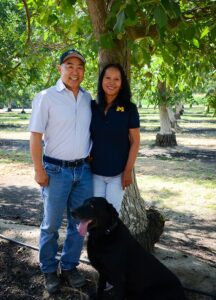
Q. Tell me a little bit about the history of your farming operations.
My grandfather immigrated from Japan in the early 1900s. He and my grandmother settled in the Hanford area in the early ’20s. They raised eight children on the farm, three girls and five boys. Two remained on the farm after World War II (my father Harry and Uncle Kiyoshi).
This goes back to the early ’40s, maybe late ’30s, when my grandfather, father and uncle started with 10 acres of trees, and they would harvest it by hand. They put the nuts in the back of the truck and hauled it into Sequoia Walnut. They would haul the walnuts in the back of the truck, dry the walnuts on the ground then haul it into market.
Their main crop was fruit trees, and they would cut fruit and dry fruit on the ground. We slowly began planting more and more walnuts as the years went on. When my brother and I took over the family farm, we went from 200 acres to 500 acres of walnuts. Now we’re down to 250 acres of walnuts.
We have almonds and pistachios. Pistachios are about 150 acres, and our almonds are about 70 acres. The pistachios were the first nut we branched out into about 15 years ago. We do enjoy farming the permanent crops. At the time, it was a little bit more stable income working with permanent crops.
Q. How does diversification play into your farm plan?
Going back 30, 40 years, that was my dad and uncle’s thinking to diversify the farm. Cotton, corn, wheat, plums, peaches, nectarines, apricots. We had quite a few different crops going. Then we started converting over to more of the nut crops. With economies of scale, we could purchase things like walnut shakers and pickers. We harvested walnuts and almonds ourselves.
We still do the corn and the wheat on rotation. A ways back, corn and wheat were just our rotation for our permanent crops, but we’re going back with corn and wheat as a permanent crop. We have to adapt to the times. We’re probably going to have to sell some farm ground to continue farming.
Q. How has the economy affected your ability to farm?
Farming is my full-time gig. I also have my real estate license. I was coaching high school tennis for almost 15 years, not really for the money. Now I quit the coaching because the farm isn’t doing that well. We had to lay off some of the employees due to the California economy. We had to reduce our workforce. What it means is I have to work more. Now I’m on the tractor, I’m irrigating. I’m doing it all.
It’s a great lifestyle if you enjoy it. The younger generation doesn’t like the long hours and working seven days a week.
Q. How have your farming practices evolved in recent years?
My grandparents and father started shaking trees with poles, washing, drying and hulling them on the driveway. Some of the drying was done on wooden fruit trays.
We currently run two shakers, two sweepers, a desticker and a self-propelled picker. We move nuts from the field in shuttles and use a pivoting elevator to load trucks. We have moved from a few acres around a house to nearly 500 acres of various varieties. Recently, we removed acres of older varieties.
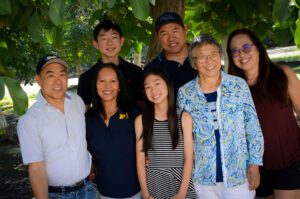
Q. What new production practices have you embraced and why?
GPS planting, moisture probes, microsprinkler irrigation. It’s more efficient and makes decision-making easier.
Our first automation project was on the almonds. We can see what the almonds need. We can see the moisture draw of the almond tree at different depths. We can see which profile of the soil needs water. The lower levels of the soil will deplete faster most of the time, so then we need to get water deeper into the soil profile. That tells us that we need to irrigate a little bit longer. Or if we have a rainy year, we might need to irrigate less. It’s all about maximizing the longevity of the tree.
The automation makes it so I don’t need to be in the field to see problems. I can see problems on my phone. Recently, I was on the beach, and they said we’re having problems starting up the irrigation system. I was able to start the water for the guys from my phone.
Q. What are the three things that keep you up at night related to growing tree nuts?
Why have nut prices fallen from $1.80/pound to $0.25/pound. How long can we keep losing money? Where are we going to get water and how much will it cost us?
I would rather go back to how we were successful by growing profitable crops rather than relying on disaster and emergency relief government payments. How do we afford the increasing wage rates with decreasing employee hours? How can we afford chemicals and fertilizers? Should I apply for low-income programs for medical, food and insurance?
Since we have few choices to insure our business and with the increasing prices of expenses and lower income, do we need to continue farming? With the lowest net income in nuts, do I put the steak back at Costco and buy a $1.50 hotdog?
Q. What are you most hopeful for in the future when it comes to farming tree nuts?
A better political environment for reasonable tariffs to open and grow international markets. Our pistachio future may look the brightest but there are concerns in that area also.
Q. What in your opinion needs to happen to set the industry in the best possible direction for the future?
We need to not only expand markets domestically but internationally. In my travels overseas, there is potential to grow markets with the right environment. Education and research have always helped propel California agriculture in the right direction. Research needs to continue to give all farmers the tools to become better.
California farmers are the best farmers in the world but with all the government regulations, do the regulators think they know how to farm better? Do regulators make us produce better, healthier or safer food? Let farmers farm.
Q. What do you think the biggest assets are of the tree nut industry in California?
We can produce the best, healthy and safest food in the world. The farmers know how to farm, but with all the regulations, who is actually farming?
Q. What is your proudest achievement as it relates to your professional development?
I have many achievements, such as being the past president of the KCFB, current president of the Excelsior/Kings River RCD, a past advisor of the FSA and serving on other boards. Our family have received the Kings County Agriculturalist of the year award and many years ago received the highest quality award with Diamond Walnut.
With all this, my proudest achievement has been coaching tennis at the high school level for 15 years, not only winning seven league titles, seven Valley and Central Section championships, but I’m most proud of developing the athletes into successful contributing people to society. This might not sound like professional development, but because of our success in agriculture, I was able to take time to help high school students. I was able to send both of my children to Ivy League schools because of agriculture, and what’s more professional than developing more professional people than yourself?
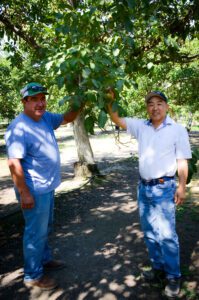
Q. What advice do you have for a young person getting into farming tree nuts today?
Farming is not for everybody. Get an education! You need to work for others, and often family is not the only path. Don’t be afraid to ask questions. You can’t be afraid of long hours, working seven days a week, getting dirty, and most importantly, advice you get is not always correct. Learn by doing!
Q. Who was the biggest influence or mentor for you in your career?
It has to be my dad because it’s not only what you learn in books and school, but you need to have a person show and explain why things are done a certain way. He was patient in a way that I could express my own opinion and he would listen. He was able to accept change and still laugh and smile when things didn’t always go right.
Q. What do you think the biggest advancement has been in the field of tree nut growing during your career?
Technological advancements in the past decades are unbelievable. We use drones to spray, irrigation has moved from multiple shift irrigators to managing water with an iPhone. It’s too bad that advancements are being slowed by regulations and low prices.
Q. What advancements do you foresee having a big impact in the future?
New drought-tolerant crops. Pistachios are a more drought-tolerant crop, and it still has a fairly high value when you weight the value and the cost of water. Even short-term, our politically caused droughts are really going to weigh on us. I understand there’s more non-bearing acres than bearing acres. A lot of people are doing it because it is more drought tolerant.
I think people aren’t planting as many pistachios as they have been. We’re looking at other crops, whether it be olives or something else. You almost have to find something that nobody else is thinking about. We’re even fallowing some ground that we’ve never done so that we don’t lose as much.








